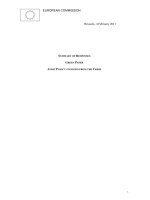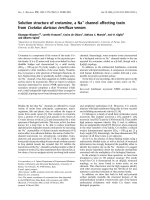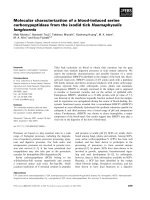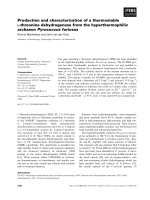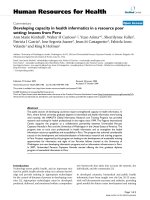Diary of a Professional Commodity Trader: Lessons from 21 Weeks of Real Trading_6 doc
Bạn đang xem bản rút gọn của tài liệu. Xem và tải ngay bản đầy đủ của tài liệu tại đây (997.68 KB, 24 trang )
Once a position has been established and the initial
protective stop has been set, there are a number of
techniques used by the Factor Trading Plan to exit a trade.
In nearly all cases, trade profits are taken if a market
reaches the target implied by the pattern that launched the
trade. Stops are also advanced in the direction of the
position using several methods, including the Retest
Failure Rule, the Trailing Stop Rule, and the Intervening
Pattern Rule. Explanations and examples of these methods
to move protective stops are found in Chapter 3.
Trade Order Management
Whereas trade risk management deals with the
determination of the risks and leverage taken on any trade
or combination of trades, trade order management deals
with the actual physical process of entering and exiting
trades.
My job as a trader is really nothing more than that of a
glorified order placer. At its irreducible level, trading is
basically the process of entering orders. I have no control
over what the markets do. The real challenge of trading is
to identify the controllable factors and build into the trading
process means to control what can be controlled. The
markets will do what the markets will do whether I buy, sell,
hold, or do nothing. At the end of the day, the only control I
have is over the orders I enter.
I will divide this section into trade order management on
positions being considered for a new entry and trade order
management on existing positions.
Entering New Orders
I review the weekly charts for about 30 different markets
once each week—usually late Friday afternoon or early
Saturday morning. This review gives me a good idea of any
new developments taking place in the markets and if there
are any new potential trades on the horizon.
The types of weekly chart patterns I want to trade take a
very long time to develop. In fact, there are only about two to
three significant weekly chart patterns that qualify an
individual market for a trade in any given calendar year.
Finding more than three weekly chart patterns in a specific
market even during a strongly trending year would signify
that I might be reading more into the charts than I should.
By early Saturday afternoon, I have a pretty good idea if
an entry trade will set up in the coming week in any
markets. Usually, I see weekly chart patterns develop many
weeks, and sometimes months, before an actual pattern is
completed. This is a problem because once I see a pattern
developing, I become anxious to become involved. This is
where patience comes into play.
I print off weekly charts (and accompanying daily charts)
that might offer a trading opportunity for the coming week.
In addition to the many wonderful online charting packages
available (I use three different web-based programs), I
maintain printed hard-copy charts of the markets I am either
in or looking to enter. Part of this exercise is because I was
weaned on paper charts. I find that actually drawing in price
bars by hand each day puts me in better connection with
the markets than scrolling through updated charts on the
Internet.
Next, I turn my attention to the daily charts. I pay particular
attention to the markets identified by my review of the
weekly charts, although I look at the daily chart of the active
contract of every market in which I would consider a trade.
While my bias is to focus on weekly charts, daily charts
provide more trading opportunities than revealed by the
weekly charts.
If a daily chart trading opportunity develops during the
week, I will print out a hard copy of that chart. At about 2 PM
Sunday, I gather the charts printed the previous day. It is at
this time I determine the entry strategy, risk parameters,
and leverage I will use for each market, assuming that a
pattern breakout occurs. I launch the online trading
platforms I use and begin placing entry orders and setting
up trading alerts so that I will automatically be notified if any
of my entry orders are executed.
I most commonly use good-until-canceled (GTC) open
orders to enter and exit trades. Some markets are
notorious for running stop orders during the nighttime hours.
I carefully avoid entering GTC stops in the night sessions in
such markets as the mini metal contracts, grains, softs,
fiber, and livestock (which I seldom trade anyway). I use day
orders in these markets, each day entering the orders when
the normal daytime trading hours commence.
By the time the Sunday afternoon markets open, I have
just about completed all of my order entry for new positions.
Orders I do not place on Sunday afternoon (such as stops
in thinly traded electronic markets) are placed early on
Monday morning. I am normally awake and have checked
Asian and European trading by about 3:30 AM mountain
time. I am not a very good sleeper.
The exact time a trader does certain tasks and the
process used are not important. I do certain things at
certain times in certain ways because it works for me. The
point is that a trader needs to develop a disciplined routine.
The time of an action is less important than the action itself.
In addition to trading, I am a private pilot. Pilots go
through a routine checklist during each phase of a flight—
from preflight to postflight. A trader needs a similar routine.
In general, only a few new entry opportunities will develop
during the trading week. It is a harsh truth that those trades I
“discover” during the week (i.e., trades I had not seen
coming the previous weekend) have probably been net
losers over the years.
Different online trading platforms offer varying
capabilities. My preference is to use trading platforms that
offer the ability to place contingency orders. This means
that if entry order using a stop is filled, then a protective
stop-loss order will be placed automatically without my
direct involvement. Without the ability to place contingency
orders I would need to pay attention to the markets during
the trading session. I will emphasize repeatedly during the
course of this book that I want distance between myself and
the markets during the trading day.
The more I follow the markets during the trading hours,
the more apt I am to make an emotionally driven decision
to override my trading plan. I know myself too well, and I
know that my emotional reactions to intraday trading will be
detrimental to my net bottom line over any period of time.
Controlling my emotions is the biggest challenge that faces
me as a trader. And this is a battle that never ends.
Existing Open Positions
Among all aspects of my trading, this is the one area that
causes me the most aggravation and stress. How to handle
a trade that immediately moves in the intended direction is
the single most difficult aspect of trading, in my opinion. I
lose sleep over this trading challenge. It is this component
that I am most tempted to tweak at any given time based on
trades that immediately preceded the moment.
It is easy for me to enter a trade, easy to take quick
losses on trades that never work, easy to take pyramid
trades, and easy to take profits at targets, but enormously
difficult to deal with profitable trades that are somewhere
between the entry point and the target.
At its most basic level, managing an open trade boils
down to a balance between protecting a profit and allowing
a trend the opportunity to run its course as implied by a
completed chart configuration.
The process of entering orders on exiting positions is
similar to that of the order flow for new trade entries. For
every position held, two orders are in place in the market—
a “limit” order for taking profits at the target and a stop
order for exiting the trade if it turns against me. These two
orders are commonly known as OCOs—one cancels the
other. Within minutes of entering a new trade, I place both
of these exit orders.
Each afternoon, I review the daily charts for each market
in which I carry a position and make a determination
whether any order should be modified. Most modifications
occur during the late afternoons between the end of the day
session when the closing prices are established and the
beginning of the evening session, which represents the
start of the next day’s trading schedule.
Chapter 6 provides numerous specific examples of the
tactics used in trade management by examining actual
case studies.
Best Trading Practices
Best practices are those things that would contribute positively
to a net bottom line over an extended period of time if followed
habitually. Worded in the opposite way, not doing the best
practices will likely reduce profitability. Maintaining and
reviewing a list of best practices can keep a trader grounded in
a right mind-set. Best practices vary from trader to trader. My
best practices would include the following items dealing with
order management:
Review weekly charts only on Saturday when the
markets are closed.
Scroll through every market that I consider trading. Use
the weekly rollover continuation charts as well as the
weekly chart of the most actively traded contract month
in the case of futures markets.
Look at daily charts only once each day—during
nontrading hours.
Place entry orders only once each day and do not
second-guess the original order once the trading
session begins.
Avoid intraday charts. Avoid watching markets during
the trading day.
Do not pay attention to any other trader or analyst. Base
my trades on my own approach.
Points to Remember
A trader must have an organized method to
resolve what constitutes a trading signal. Time
phasing is a hurdle all traders must clear in order
to be consistently successful.
A trader must have a framework that defines an
overall trading plan, including how to enter trades
and how to determine the risks involved. Most
professional money managers risk no more than
1 percent on each trading event.
A strategy for exiting trades must be part of a
trading plan.
A trading plan must address the issue of risk
management, namely, what proportion of capital
will be risked on any given trading event.
A trading routine, especially analysis and order
entry, should be developed and followed.
Chapter 6
Three Case Studies Using the
Factor Trading Plan
This chapter presents case studies of actual markets
traded in 2009 by the Factor Trading Plan to illustrate the
rules, guidelines, and principles introduced in earlier
chapters of the book.
This chapter will use completed charts to answer such
questions as:
What does a trading signal looks like?
How is a signal generated within the trading
plan?
How do I determine the placement for initial
protective stops?
How do I determine the number of contracts (i.e.,
the leverage for the trade)?
What guidelines do I use to advance stops in the
direction of a profitable trend?
What provision is made for pyramiding a trade,
and how does it work?
How do I take profits?
The three case studies in this chapter include a
particularly memorable and significant technical event
producing two trades in the Dow Jones Industrial Average
(DJIA) contract, a full year of trades in gold, and finally, a full
year of trades in sugar.
These case studies were selected because they were
markets in which I was active in 2009 and a variety of
trading situations were presented. Gold and sugar were not
typical markets in 2009. In fact, gold produced one of the
best trades of the year and sugar was my single most
profitable market for the year. I could have presented a
case study in a market like the euro currency and U.S.
dollar cross rate (EUR/USD) but chose not to. For the
purpose of full disclosure, please know that there were
some markets that completely frustrated me in 2009.
A Remarkable Technical Event
in the Dow Jones
The DJIA produced a short trade followed by a long trade
that will be featured in future textbooks on classical charting
principles. A short trade is one in which a trader bets on a
price decline. A long trade is one in which a trade bets that
prices will climb. In forex and commodities, the sequence in
which a trader buys and sells does not matter. A short
position is established when a trader sells first, hoping to
profit when a buy is made at a lower price. The opposite is
true for a long position.
Short Trade: July 6, 2009
Once I identify a pattern that qualifies as a candidate trade,
I place an entry order on my trading platform. Figure 6.1
shows the September 2009 contract of the Mini Dow
Jones. On July 2, I identified a possible H&S top. I
immediately placed an order to short the market if the
neckline and right shoulder low were penetrated. My sell
stop was at 8182. I became short on July 6.
FIGURE 6.1 An H&S Top in the Dow Jones Industrial
Average.
The primary method used to establish the initial
protective stop is the Last Day Rule. This rule is based on
the assumption that the breakout day is sacred and that the
high of a downside breakout day or the low of an upside
breakout day will be the demarcation point between the
trading range of the pattern and the start of a sustained
trend. As a very general rule, I risk a short trade to above
the high of the day during which the breakout occurred (or
to below the low of the upside breakout day). When very
little of the bar of the breakout day is above the boundary
line, I may elect to revert to the day prior to the breakout day
to determine the Last Day Rule.
When the September Mini Dow broke out on July 6, only
30 points existed above the neckline of the H&S top. So, I
elected to use the previous day’s high and selected a stop
of 8316, representing a potential loss of $670 per contract.
I shorted a single September Mini Dow contract per
$100,000 of capital based on my normal risk tolerance of
approximately six-tenths to eight-tenths of 1 percent.
I use the targeting methods detailed by Edwards and
Magee in Technical Analysis of Stock Trends —a market
breaking out of a chart formation will trade a distance equal
to the height of the pattern itself. The high of the head within
the H&S was 8828. The low of the right shoulder was 8194.
The difference of 634 Dow points projected down from
8194 yielded a target for the trade of 7560. When I was
filled on my short, I immediately entered an open order to
cover the short at 7561.
My short position closed against me the very day I
entered it. This is never a good sign. My historical bottom
line would be greatly improved if I immediately had exited
every trade that ever closed at a loss. Yet, the following day,
July 7, the market dropped throughout the day and closed
decisively below the neckline of the H&S top. This gave me
a renewed cause for optimism. It also gave me an ability to
move my protective stop to 8302, just above the July 7 high,
a revised Last Day Rule. The market stopped me out on
July 14 to officially end the trade, called the original H&S
interpretation into doubt, and set the stage for a long
position.
I should have known that the H&S top was suspect—the
pattern was being discussed frequently on CNBC. Patterns
being acknowledged as conventional wisdom normally do
not work out as planned.
Long Trade: July 15, 2009
A pattern that I have found to be quite tradable in
commodity futures and forex markets is the H&S failure. I
consider this to be a pattern unto itself. The H&S failure
pattern starts with a recognizable H&S formation. Whether
the H&S is completed with a minimum of follow through (as
in the case of the Dow) or the right shoulder begins to form
but does not break the neckline, the signal is generated
when the market climbs above the peak of the right
shoulder of the H&S top (or declines below the right
shoulder low of a H&S bottom).
After being stopped out of my short September Dow on
July 14, I immediately placed a buy stop above the right
shoulder high. As seen in Figure 6.2, it was filled the very
next day, July 15, at 8568.
FIGURE 6.2 Textbook H&S Failure on the September
DJIA Chart.
The Last Day Rule was based on the low of July 14 at
8327. I set my protective stop at 8319. The risk from 8568
to 8319 was $1,245 per contract, far greater than my
desired risk of about $700 per capital unit of $100,000. So,
I was faced with one of two decisions: to use a money
management stop rather than the Last Day Rule or to
restrict leverage to one contract per $200,000. I chose the
latter option. By risking a position of one-half of a contract
per $100,000 to 8319, my risk level was about six-tenths of
1 percent ($1,245 divided by 2).
The objective of an H&S top failure is determined by
projecting the height of the H&S upward from the high of the
right shoulder. In this case, I projected the height of the
original H&S of 634 points upward from the July 1 right
shoulder high of 8527, producing a target of 9161. This
target was met on July 30. In the case of the long trade in
the Dow, the profit was $3,100+ per contract, or $1,550 per
$100,000 unit of capital.
There is an overpowering temptation to remain involved
with a market that just provided a nice profit. The emotion
of greed almost demands an immediate re-entry into the
trade lest money be left on the table. When facing this
emotion I need to remind myself that there will be new
opportunities next week, next month, and next year.
Discipline demands that once I exit a trade I need to go
shopping in a different market. Incidentally, rather than
taking profits at the target I could have elected to use the
Trailing Stop Rule, which was triggered on September 2.
A Year Trading Gold
In 2009, the Factor Trading Plan entered seven trades in
gold. Even though I traded the individual futures contracts,
for ease I will trace the trading history on the weekly and
daily continuation charts. Figure 6.3 displays an overview of
my year of trading gold.
FIGURE 6.3 Gold 2009 Trades.
On January 23, I entered a long gold trade as the market
broke out of an H&S bottom and trend line dating back to
July 2008. See Figure 6.4. I bought a mini contract (a total
of 33 ounces) of April gold at 884.2 per $100,000 of
capital. My initial stop was just under the Last Day Rule at
853.8 with a risk on the trade of about 1 percent of assets.
FIGURE 6.4 Gold Trade #1—H&S Completed in January.
I made mistakes on this trade. My interpretation was very
flawed. A legitimate H&S pattern occurs when the head
and both shoulders are singularly part of a process by
which “strong hands” are distributing or accumulating a
position. In hindsight, the right shoulder in January was
probably disconnected with the left shoulder of September
2008. I think I was probably just looking for an excuse to be
long gold. An H&S configuration that comprises just a
portion of a more extensive trading range should always be
treated as suspect. I tend to go in streaks with my
interpretations. For a while, I see H&S on most charts I
study, then for another period of time I see wedges
everywhere I look, then it might be triangles, then channels.
I exited the trade on February 25 at 958.2 using the
Trailing Stop Rule. Figures 6.5 and 6.6 display the threestep process of the rule.
FIGURE 6.5 Gold Trade #1—Trailing Stop Rule in Gold.
FIGURE 6.6 Gold Trade #1—Trailing Stop Rule
Demonstrated.
A Government Report Causes Volatility
and a Quick Loss
Several times per year a market will spin me faster than I
know what is happening. This was just such a case, as
shown by the out-of-line movement in Figure 6.7.
FIGURE 6.7 Trade #2—An Out-of-Line Movement in Gold.
On March 18, I was stopped into a short position at
888.7 when the market sliced through the neckline of an
H&S top early in the session in response to a government
report.
The Last Day Rule at the time of the fill was at 916.3, but I
used a money management stop of 900.7 in order to
extend my leverage to two mini contracts per $100,000. I
was risking about eight-tenths of 1 percent on the trade. I
was literally stopped out within minutes. Back in the “good
old days” of pit trading, I remember at times getting back a
fill on my protective stop before getting the fill on the entry
order. Talk about adding insult to injury!
Trading a Short Position on a Small
Pattern
Keeping with my obsession over H&S patterns, I shorted
one contract of August mini gold on June 12 at 942.4 (see
Figure 6.8). This was way too small a pattern for me to be
trading and was a violation of my basic guidelines.
FIGURE 6.8 Trade #3—A Small H&S Pattern in Gold.
Knowing that this was not a good trade, I jammed my
protective stop, exiting the trade with a very small profit on
June 24. I considered myself lucky for cheating my rules on
the required duration of an acceptable daily chart reversal
pattern.
Another H&S Pattern Fails
Continuing the H&S theme I went long mini gold on August
4 based on the completion of a seven-week H&S bottom
with an upslanting neckline, as shown in Figure 6.9. On
August 6, the market had a hard intraday retest of the H&S
pattern. I adjusted my stop to just below the August 6 low
based on the Retest Rule. I was stopped out for a six-tenths
of 1 percent loss on August 7.
FIGURE 6.9 Trade #4—Another Failed H&S in Gold.
I hope these case studies are communicating a
message I want to send clearly—that trade entry signals
are relatively unimportant to my overall success. What I
trade—indeed, what I call an entry signal—is secondary to
money and risk management. Trade selection is highly
overrated.
Spotting the Big Move
In early August, it was becoming apparent that something
big was just around the corner in gold. The weekly chart
displayed a massive inverted continuation H&S pattern, as
shown in Figure 6.10. This rare pattern was discussed
briefly by Edwards and Magee in Technical Analysis of
Stock Trends and earlier by Schabacker in Technical
Analysis and Stock Market Profits: The Real Bible of
Technical Analysis.
FIGURE 6.10 Trades #5 and #6—H&S Pattern on Weekly
Gold Chart.
Further, the right shoulder of the H&S was taking the form
of a six-month symmetrical triangle. The triangle had six
significant contact points (labeled A-F in Figure 6.11). I get
very excited when I see markets set up in such a
magnificent way.
FIGURE 6.11 Trades #5 and #6—A Massive Symmetrical
Triangle Serving as the Right Shoulder on the Gold Chart.
The advance on September 2 penetrated the upper
boundary of the triangle and then rose above the last
defining high within the pattern (point E). I went long
December gold at 978. The objective of 1094 was
determined by extending the distance from B to C upwards
from E. Calculating the A to B distance would have also
been acceptable. While I took profits at the target on
November 4, the Trailing Stop Rule would have kept me in
the trade until December 7. I could have gained another
$45 per ounce—there is always another case of coulda,
woulda, shoulda!
It is important to note that the lows of the breakout day of
September 2 and the upthrust day of September 3 were
never challenged. This is often the case with a substantial
and valid breakout. Immediately following the breakout, the
market drifted sideways for a month. In the process, the
market appeared to be forming a small H&S top. I even
advanced the protective stop on a portion of my long
position to below the neckline of this small pattern (see
Figure 6.12). On October 5, the market advanced through
the existing right shoulder high of this small H&S pattern,
providing a pyramid signal at 1014 with a target of 1050
(met quickly on October 8). I chose not to take profits at the
target. Again, note that the Last Day Rule, the low of
October 5, was also never challenged.
FIGURE 6.12 Trade #6—A Small H&S Failure in Gold.
The Gold Market Throws a Curve Ball
Seldom does a trade go from entry to the target without
difficulty and challenge. The best laid plans of mice and
men! Such was the case with the pyramid position
established at the breakout of the four-week H&S failure on
October 5 (trade #6). I chose not to take profits on this
trade at 1050. Then, the decline on October 26 completed
a small double top and placed the run for the glory into
question. The October 26 decline was also a setup day for
my Trailing Stop Rule. October 27 was the trigger day for
the Trailing Stop Rule, but I did not jam my stop until the
next day, when I was stopped out near the low of the bull
market correction, as seen in Figure 6.13.
FIGURE 6.13 Trade #7—Fake-Out in Gold.
This situation created one of the most difficult challenges
facing a trader—what to do when stopped out of a
successful trade prior to the attainment of a much larger
target. Unfortunately, there are no easy answers to this
challenge, but there are some lessons.
Within days of completing the three-week double top, the
market returned to its dominant bull trend. This raised the
real possibility that the small top was a bear trap. It also
established the possibility that the market was creating a
fishhook buy signal. This is not a Magee and Edwards
pattern, but something I have observed in my years trading
chart patterns. A fishhook signal occurs when a pattern
quickly fails followed by an immediate trend back into the
failed pattern. The dynamic behind a fishhook buy signal is
that weak longs get stopped out.
Markets almost always force sold-out bulls to chase a
trend. The first real sign of a fishhook buy signal was on
November 2 when the entire trading range was above the
lower boundary of the three-week double top and the
market closed near the high. I could have reentered at this
point, but I stubbornly waited for a new high on November 3.
Fishhooks most often signal halfway moves that can be
projected using swing targeting (see Figure 6.14).
FIGURE 6.14 A Swing Target in Gold.
The advance from the October 2 low to the October 14
high was approximately $85. Projecting this amount
upward from the October 29 low of 1027 yielded a target of
1112, met on November 12.
Lessons from Trading Gold in 2009
I hate being jerked around in the markets. I hate buying at
the top end of a trading range and selling at the bottom
end. I hate false breakouts. I dread being right on the
direction of a market but losing money by getting
whiplashed in the process. This can happen if I get stopped
out of a long on weakness, reenter on strength, get stopped
back out on weakness, and so on. It is possible to lose $50
per ounce in a $20 trading range in gold and end up correct
on the subsequent direction.
A choppy market does damage financially. Choppy
markets can impose emotional and confidence
consequences on a trader that are far worse. I can’t
remember all the times I have missed really big moves
because I was gun shy from a period of choppiness that
preceded the big moves.
The biggest temptation after a premature stop-out is to
get right back in before receiving another solid signal.
Getting into this cycle throws discipline and patience right
out the window. I got lucky on trade #7 in gold. Had this
trade slapped me around, my head would have really been
screwed on wrong.
The second lesson is that smaller reversal patterns, such
as the little double top, are not likely to provide a serious
threat to a trend that began with a strong thrust out of a
substantial pattern (the triangle in the case of gold),
especially when the market has a great distance to go to
reach the implied target.
Table 6.1 summarizes the gold trading signals in 2009.
TABLE 6.1 Record of Gold Trading Signals in 2009
The target of the 1320 from the inverted 18-month H&S
on the weekly chart has not been met as of this writing in
January 2010. This fact has imposed a bullish bias on my
view of gold.
I waste a lot of ammunition by taking trading decisions
within broader trading ranges—by not waiting for the
decisive breakout. This was the case for the first four gold
trades in 2009. It was not until the trades #5 and #6 that the
market was really breaking out of a major pattern. Trade #5
was really the only trade worthy of the Best Dressed List.
Exiting a Trade
There are six general conditions I use to exit a trade once it
has been established: two with the trade at a loss and four
with the trade at a profit.
At a Loss
1. The chart pattern breakout I use to enter the
trade is either a failure or a premature breakout.
The market reverses and penetrates my Last Day
Rule stop (or money management stop if used
instead of the Last Day Rule for risk management
reasons. (See Figure 6.7 for an example.)
2. The breakout fails to provide immediate thrust
in the direction of the trade. Within days (per
perhaps a week or so) the market experiences a
hard retest of the pattern, penetrating the
boundary line used to enter the trade. If a hard
retest occurs, I may elect to adjust my protective
stop in relationship to the hard retest. (See Figure
6.8 for an example.)
At a Profit
1. At the target. I normally take profits at the target
indicated by the chart pattern used to initially
establish a trade. (See Figures 6.11 and 6.14 for
examples.)
2. Successful trades often develop smaller chart
patterns during the course of a trend. Depending
on the nature and duration of these continuation
patterns, I may even pyramid a trend. I will also
use the Last Day Rule of a continuation pattern to
advance the protective stop on the initial position
in the direction of a successful trend.
3. Prior to the attainment of a target, a market
may form a pattern with implications counter to the
position. In other words, an intervening pattern
indicates that a reversal of trend is possible. I may
elect to advance my protective stop in relationship
to this intervening pattern. (See Figure 6.13 for an
example.)
4. At any time during the course of a trend, I may
choose to elect the Trailing Stop Rule. (See
Figure 6.5 for an example.)
A Year Trading Sugar
Sugar was the market of my single most concentrated
focus in 2009. My opinion of sugar in 2009 highlights the
fact that as a chartist I am not a detached market observer.
My biases often dictate my chart analysis.
Sugar was also my single most profitable market in
2009. As part of full disclosure, I want to emphasize that my
trading experience in sugar in 2009 is not typical of my
experience in most markets in most years. I only wish this
could be the case. In fact, sugar provided nearly 40 percent
of the net signal profits in 2009.
Y the market completely frustrated my bullish bias
et
during the first four months of the year as I lost money on
trade after trade. Just because I am ready for a market to
make a move does not mean that the market is ready to do
so—or that it will ever be. A market could care less if I am
bullish or bearish. In fact, if I am a bull, once I do my buying,
my only influence is as a bear because I become a source
of selling.
Starting the Year a Bull
I was a sugar bull on the first day of January in 2009. Figure
6.15 displays the weekly pattern I thought was dominant at
the time, a possible nine-month continuation symmetrical
triangle. In early 2009, the market was at the lower
boundary of this triangle, so I was interested in establishing
an anticipatory long position.
FIGURE 6.15 Sugar Weekly Chart in Early 2009.
Little did I understand how frustrating that process would
become. Figure 6.16 shows a daily continuation chart
listing all 11 of the Factor trading signals in 2009. My
obsession with sugar resulted in far too many trades. An
obsession with a market leading to overtrading has
happened to me before, and it will happen again.
FIGURE 6.16 Trading Sugar 2009: 11 Trades.
Three Losing Trades Started the Year
Figure 6.17 shows the first three trades of 2009 in sugar.
All three trades were losers despite the fact I was a major
bull and the market was rising. Losing money trading the
long side of a rising market challenges one’s durability and
